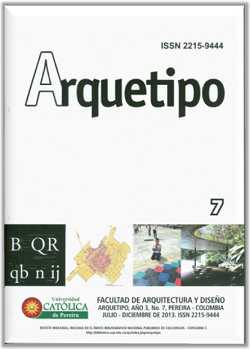Eco-enveloping evaluated from a product lifecycle analysis.
Keywords:
Life cycle, thermal comfort, competitive advantageAbstract
The green-envelop project proposed the development of a module to identify its thermal comfort after placing a green-envelop. Likewise, it was sought that the construction of this module matched environmental criteria, consequently, a Life Cycle Analysis (LCA) was chosen to determine the best option. The project, in its environmental analysis component, proposed a methodology that involved the use of two tools for the development of the analysis, in order to give greater strength to the results. The proposal was theoretically based on guidelines of the natural resource-based view of the firm. Thus, it is also planned that the solutions that can be defined with support of this analysis are framed within an environmental strategic dimension.
References
Barney, J. (1991). Firm Resources and Sustained Competitive Advantage. Journal of Management, 17(1), 99.
Boks, C. (2006). The soft side of ecodesign. Journal of Cleaner Production, 14(15– 16), 1346-1356. doi: 10.1016/j.jclepro.2005.11.015
De Bakker, F. G. A., Fisscher, O. A. M. & Brack, A. J. P. (2002). Organizing productoriented environmental management from a firm’s perspective. Journal of Cleaner Production, 10(5), 455-464. doi: 10.1016/s0959-6526(02)00012-4
De Lange, D. E., Busch, T. & Delgado-Ceballos, J. (2012). Sustaining Sustainability in Organizations. Journal of Business Ethics, 110(2), 151-156.
Estrela, S. (2011). Life Cycle Thinking in Canada. Journal of Industrial Ecology, 15(4), 479-482. doi: 10.1111/j.1530-9290.2011.00363.x
Fowler, S. J. & Hope, C. (2007). Incorporating sustainable business practices into company strategy. Business Strategy & the Environment (John Wiley & Sons, Inc), 16(1), 26-38. doi: 10.1002/bse.462
Hart, S. L. (1995). A Natural-Resource-Based View of the Firm. The Academy of Management Review, 20(4), 986-1014.
Hart, S. L. (1997). Beyond Greening: Strategies for a Sustainable World. Harvard Business Review, 75(1), 66-76.
Hart, S. L., & Dowell, G. (2011). Invited Editorial: A Natural-Resource-Based View of the Firm: Fifteen Years After, Editorial, Journal of Management, pp. 1464- 1479. Retrieved from http://search.ebscohost.com/login.aspx?direct=true&d b=bth&AN=65152028〈=es&site=ehost-live
Heiskanen, E. (2002). The institutional logic of life cycle thinking. Journal of Cleaner Production, 10(5), 427-437. doi: 10.1016/s0959-6526(02)00014-8
Hossaini, N. & Hewage, K. (2012). Sustainable Materials Selection for Canadian Construction Industry: An Emergy-Based Life-Cycle Analysis (Em-LCA) of Conventional and LEED Suggested Construction Materials. Journal of Sustainable Development, 5(1), 2-12.
ISO. (2007a). NTC-ISO 14040. Gestión Ambiental. Análisis de Ciclo de Vida. Principios y Marco de Referencia (pp. 24). Bogotá: ICONTEC.
ISO. (2007b). NTC-ISO 14044. Gestión Ambiental. Análisis de Ciclo de Vida. Requisistos y Directrices. Requisitos del Ciclo de Vida. (pp. 50): ICONTEC.
Lewandowska, A. (2011). Environmental life cycle assessment as a tool for identification and assessment of environmental aspects in environmental management systems (EMS) part 1: methodology. The International Journal of Life Cycle Assessment, 16(2), 178-186.
Lin, H. (2012). Cross-sector Alliances for Corporate Social Responsibility Partner Heterogeneity Moderates Environmental Strategy Outcomes. Journal of Business Ethics, 110(2), 219-229. doi: http://dx.doi.org/10.1007/s10551-012- 1423-2
Poudelet, V., Chayer, J., Margni, M., Pellerin, R. & Samson, R. (2012). A processbased approach to operationalize life cycle assessment through the development of an eco-design decision-support system. Journal of Cleaner Production, 33(0), 192-201. doi: 10.1016/j.jclepro.2012.04.005
Sharma, S. & Vredenburg, H. (1998). Proactive Corporate Environmental Strategy and the Development of Competitively Valuable Organizational Capabilities. Strategic Management Journal, 19(8), 729-753.
Suh, S. & Huppes, G. (2005). Methods for Life Cycle Inventory of a product. Journal of Cleaner Production, 13(7), 687-697. doi: 10.1016/j.jclepro.2003.04.001
Van Berkel, R., Van Kampen, M. & Kortman, J. (1999). Opportunities and constraints for Product-oriented Environmental Management Systems (P-EMS). Journal of Cleaner Production, 7(6), 447-455. doi: 10.1016/s0959-6526(99)00232-2
Von Bahr, B. & Steen, B. (2004). Reducing epistemological uncertainty in life cycle inventory. Journal of Cleaner Production, 12(4), 369-388. doi: 10.1016/ s0959-6526(02)00197-x
Wernerfelt, B. (1984). A Resource-Based View of the Firm. Strategic Management Journal, 5(2), 171-180.
Yin, R. K. (2009). Case Study Research. Design and Methods (Fourth Edition ed.): Sage Publications inc., USA.

